Scientific Family. The Giant Clams belong to the genus Tridacna (Bruguière 1797), of which Tridacna gigas is the largest living immobile bivalve mollusk in the world. The Giant Clam is known as “Taklobo” in the Philippines. They live in the shallow coral reefs of the South China Sea, West Philippine Sea, Sulo Sea, Red Sea, but mainly in the Indian and South Pacific oceans. The word Tridacna came from the Latin word ‘Tri’ meaning three, and ‘dacn’ from the Greek meaning bite, or “Three Bites,” perhaps after the wavy shape of the clamshells. They have been around for over 38 million years. Antonio Pigafetta, the Italian navigator who joined Ferdinand Magellan in his sea travels around the world, documented these Giant Clams as early as 1521 in his journal. Eight (8) of the twelve (12) known existing Giant Clam species in the world are found in the coral reefs of the Philippines. They have a lifespan between 100-200 years. Giant Clams have hundreds of eyes along the edges of its mantle. The eyes are used to detect shadows to warn them of potential predators. The eyes are sensitive to green, blue, and ultraviolet light. This helps the clam position itself toward the sun to expose as much algae for photosynthesis. The eyes also detect excessive amounts of potentially harmful UV rays.
Feeding. The Giant Clams can either filter-feed themselves or rely on photosynthesis. They use the cilia in their gills to filter phytoplankton and absorb oxygen from the water. The Giant Clam’s mantle tissues act as a habitat for the single-celled algae, zooxanthellae, from which the adult clams get most of their nutrition. The clam opens its shells and exposes its mantle tissue so that the algae can receive ample sunlight needed for photosynthesis. Through photosynthesis, the algae deliver carbohydrates in the form of glucose and amino acids like Alanine to the clam, while the clam transfers its metabolic-products such as carbon dioxide, phosphates, nitrates, and ammonium to the algae for further utilization. Thus, the Giant Clam can grow over 39 inches (100 cm) in length even in nutrient-poor coral-reef waters. The laboratory-reared Giant Clams have been observed to grow 5 inches (12 cm) per year (Beckvar 1981). The Giant Clams cultivate symbiont algae in a special circulatory system. It is a symbiotic relationship. If the algae die, the Giant Clam will eventually die as well.
Habitat. The Giant Clams live in flat coral sand or broken corals, and can be found in shallow warm waters and depths up to 66 ft (20 m). Its populations are diminishing quickly, and the Giant Clams have become extinct in areas where they were once abundant. When a larval Giant Clam settles, it remains there for the rest of its life. In the Philippines, various species of Giant Clams live in Palawan, Eastern Samar, Maricaban Island, Silaqui Island (Bolinao, Pangasinan), Anilao Batangas, Samal Island (Davao), Negros, and Tawi-Tawi. With the help of NGOs, Giant Clams have been restocked at the sites of Anda, Pangasinan; Masinloc, Zambales; Calape, Bohol; Camotes Island, Cebu; Ilocos Norte: Tawi-Tawi; and Hundred Islands National Park.
Largest specimens. The largest known Giant Clam is a T. gigas specimen that measured 4 ft 6 inches (137 cm) in length. It was discovered in 1817 on the northwestern coast of Sumatra. The weight of the two shells was 510 lbs (230 kg). The weight of the live clam would’ve been 550 lbs (250 kg). An unusually heavy T. gigas was found in 1956 off Ishigaki Island, Japan. It measured 3 ft 9 in (115 cm) in length, and weighed 734 lbs (333 kg). The weight of the live clam would’ve been 750 lbs (340 kg).
Types of Giant Clams. The 8 types found in the Philippines are: T. gigas (Linnaeus 1758); T. deresa (Roding 1798); T. squamosa (Lamarck 1819); T. crocea (Lamark 1819); T. maxima (Roding 1798); T. hippopus hippopus (Linnaeus 1758); T. hippopus porcellanus (Rosewater 1982); and T. noae ningaloo (Roding 1798). The 4 types not found in the Philippines are: T. costata squamosina (Sturany 1899) of the Red Sea; T. rosewateri (Sirenko 1991) of Mauritius; and T. tevoroa mbalavuana (Ledua 1990) of Fiji; and T. lorenzi (Monsecour 2016) of Mauritius.
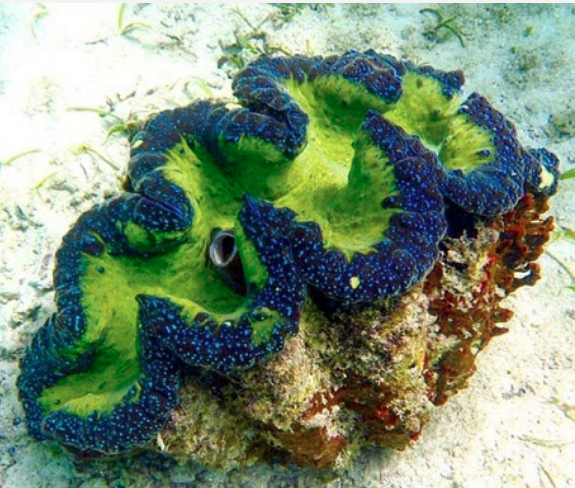
Tridacna gigas. Samal Island, Davao del Norte. Photo Credit: Geng
Geminski.
Tridacna gigas (True Giant Clam): is the largest Giant Clam with a length of 47 inches (120 cm); thickness of shell up to 4 inches (10 cm); weighs 440 lbs (200 kg), with soft parts of 22 lbs (10 kg); shell has 4-5 vertical folded rips with triangular inward projections at the upper margins of the shell; mantle is mostly golden brown, blue, green, or yellow; anchors on overgrown sponges, corals and algae; unable to close their shells in full.

Tridacna derasa. UPMSI Bolinao Marine Lab. Photo: Willie Lomibao / Inquirer.
Tridacna derasa (Smooth Giant Clam): second largest clam; grows up to 24 inches (60 cm) in length, and weighs 220 lbs (100 kg); smooth shell; has 6-7 vertical folds in its shell; hinge is relatively broad; mantle shows wavy bright green, blue lines with orange, yellow, black, or white spots; shell closes completely.
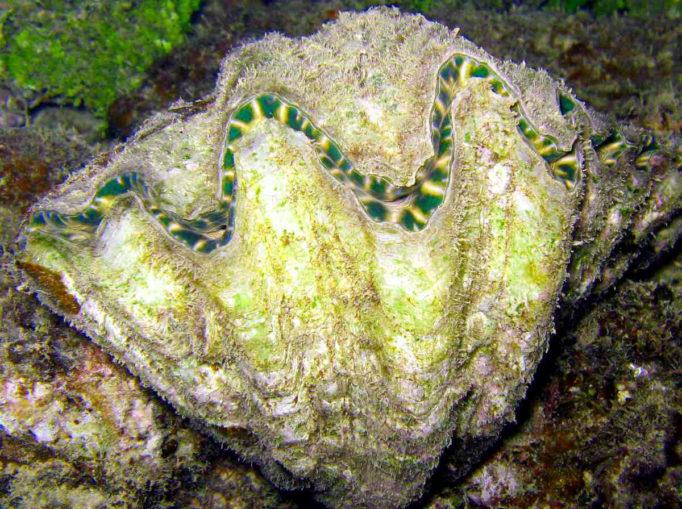
Tridacna hippopus hippopus. Palau. Photo Credit: Akvaryumist.com
Tridacna hippopus hippopus (Strawberry Clam; Bear Claw Clam): grows up to 16 inches (40 cm) in length, and weighs 22 lbs (10 kg); thick, heavy shells with triangular, horse-hoof like valves at the broad base, when the clam is closed; mantle is brown or green; red bands at the outer side of the shell gives it the name Strawberry Clam; mantle does not extend past the edge of the shell; and lacks small pinhole eyes in the mantle.
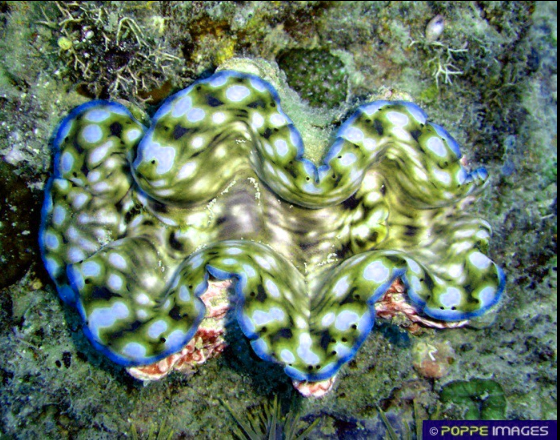
Tridacna squamosa. Camotes Island. Photo Credit: Philippe Poppe.
Tridacna squamosa (Fluted Giant Clam): grows up to 18 inches (45 cm) in length, and weigh 20 lbs (9.2 kg); thick-walled shell; rounded radial-ribs that look like ruffles; fluted scaled shell; mantle often yellow-brown mottled with blue or green wavy lines; has a widespread distribution.
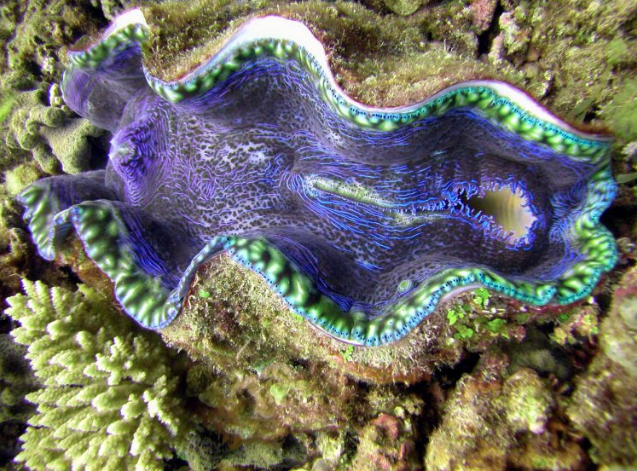
Tridacna maxima. Photo credit: Giant Clam Sanctuary, Guinsiliban, Camiguin.
Tridacna maxima (Elongated Giant Clam): largest geographical distribution; grows up to 16 inches (40 cm) in length, and weighs 18 lbs (8.1 kg); can make little movements; asymmetrical oblong stretched shells; bright blue mantle with green or brown and black spots at mantle’s edge; an aquarium-favorite; eyes are on top of raised tubercles scattered over the mantle; bores in high or low elevation islands, lagoons, and reefs; has rapid growth rate due to ability to cultivate algae inside its body.
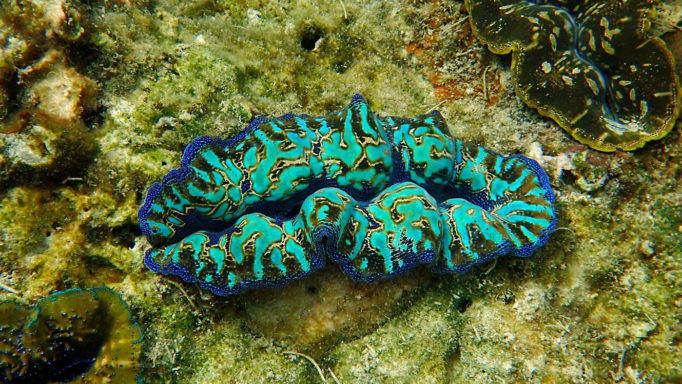
Tridacna crocea. Apulit Island, Palawan. Photo Credit: Aquaworld Acquarium.
Tridacna crocea (Boring Clam): smallest clam; grows up to 9 inches (23 cm) in length, and weighs 10 lbs (4.7 kg); bores into the corral reefs; relatively smooth, roundish-symmetrical shell with thick scutes; its colorful mantle can extend to cover the shell; eyes are on top of raised tubercles all over the mantle.
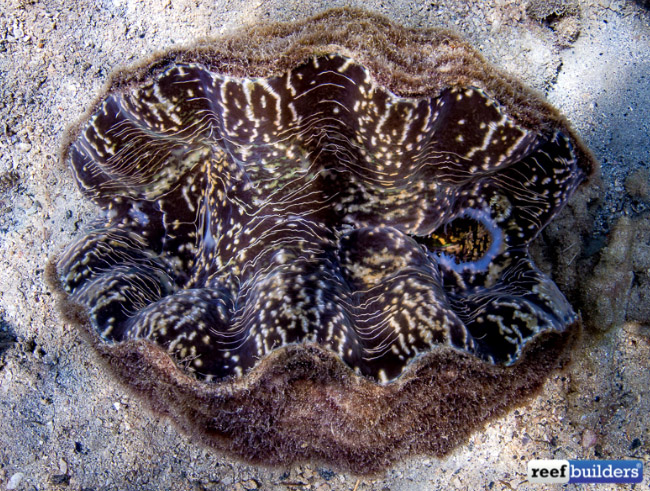
Tridacna hippopus porcellanus. Palau. Photo Credit: Reef Builders USA.
Tridacna hippopus porcellanus (China clam): Rarest species of the Giant Clam and exists in Sulu and Palawan; it grows to 16 inches (40 cm) in length, and weighs 4 lbs (8 kg); they have whitish, less ribbed shells. The mantle is mostly dark, with varying degrees of fine bluish-gray and white lines with gold spots; some specimens are psychedelic. The shape and color of the China Clam is incredibly distinct from its cousin, T. hippopus. The overall shape of the shell is much more rounded, with fewer but wider folds but much less jagged.
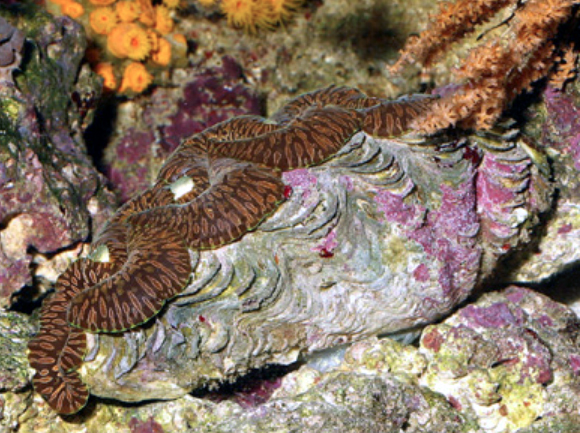
Tridacna noae. Negros. Photo credit: James W. Fatherree/Advanced Aquarist
Tridacna noae ningaloo (Noah’s giant clam; Teardrop clam), grows to 16 inches (40 cm) in length, and weighs 20 lbs (9 kg). This species was described and named T. noae (Röding, 1798). Rosewater (1965), however, assessed it as a variant of T. maxima based purely on shell structure, and T. noae lost its status as a unique species. Recently, several researchers looking at shell morphology, mantle patterns, and genetic evidence said that it is truly a unique species, thus T. noae is no longer a variant of T. maxima (Su et al 2014). It lives in Negros. Those called “Teardrop maxima” due to numerous oval spots on their mantle bordered by a thin ring of gold to white are now T. noae. It has eyes in the middle of the mantle that look like dimples.
Reproduction. The Giant Clams are hermaphrodites –producing both eggs and sperm– but self-fertilization is not possible. This allows clams to reproduce with any other member of the species, and reduces the burden of finding a compatible mate, while doubling the number of offspring produced.
Since Giant Clams are immobile, they adopt “broadcast spawning,” releasing sperm and eggs into the water. A transmitter substance called “spawning induced substance” (SIS) helps synchronize the release of sperm and eggs to ensure fertilization. Clam spawning coincides with incoming tides near the second, third, and fourth quarter of the moon’s phase. Spawning contractions occur every 2-3 minutes, with intense spawning ranging from 30 minutes to 2.5 hours. However, not all clams respond to the spawning season of neighboring clams, indicating that they may be reproductively inactive at that time. Giant Clams release eggs and sperm into the water, and the eggs are fertilized by sperm from another Giant Clam. They release more than 500 million eggs at a time (Knop 1996).
Development. The larva has 3 stages of development: (1) Trocophore; (2) Veliger; (3) Pediveliger. The Trocophore is a free-swimming larva that hatched from a fertilized egg. The larva swims in search for plankton and Habitat. At roughly one week of age, the clam settles on the ground. The larva does not yet have symbiotic algae, so it depends completely on plankton. Many small clams die at this stage. At the Veliger stage, the larva develops the first shell and an organ called “velum” that has a ring of cilia for swimming and Feeding. Lastly, during the Pediveliger stage, the larva develops a “foot” to probe the ground and find a suitable place to settle. Once the larva sets, the clam will no longer move to another location, and is referred to as a “spat” (Learn.weatherstem.com). The clam is considered a juvenile when it reaches 8 inches (20 cm) in length.
Legend. The Giant Clam has been historically misunderstood to be a “killer clam” or “man-eating clam,” and reputable scientific and technical manuals once claimed that the great mollusk had caused deaths. The U.S. Navy Diving Manual even gave detailed instructions for releasing oneself from its grasp by severing the adductor muscles used to close its shell. Today, the Giant Clam is considered neither aggressive nor dangerous. While it is capable of gripping a person’s limb, the shell’s closing reaction is defensive, not aggressive, and the shell valves close much too slowly to pose a serious threat to humans. Moreover, the largest clams, T. gigas, are unable to completely close their shells.
Predators. Smaller species like eels, shrimp, snails, fish, sea snakes, crabs, lobsters, and starfish are all known to snip small parts of the Giant Clam’s mantle.
Human interest. The Giant Clam is considered a delicacy in Japan, where it is known as “Himejako;” same in France, South East Asia and Pacific Islands. Some Asian foods include the meat from the muscles of clams. In the black market, the enormous Giant Clam shells are sold as decors. Large amounts of money are offered for the adductor muscle, which the Chinese people consider to be an aphrodisiac. American and Italian researchers teamed up to analyze the bivalves, and found the clams rich in amino acids that trigger an increase in sex hormone levels (Knop 1996). Also, the Giant Clam’s high zinc content can aid in the production of testosterone (Kurlanski 2006).
Classification Status. The IUCN 2017-3 Redlists the T. gigas T. derasa, T. rosewateri and T. tevoroa as “Vulnerable” but they have already become extinct in some areas (Neo et al 2017). The rest are just as endangered but are misclassified as “Lower Risk/Conservation Dependent.” Now considered rare to find are T. hippopus porcellanus (J. Adams 2017, Reefbuilders Inc.), and T. costata squamosina (Hawkins et al 2017).
Threats. Many who choose Giant Clams as a source of livelihood are over-exploiting the trade. Clam numbers in the wild have been greatly reduced by the excessive harvesting for food and aquarium trade by locals and bivalve fishing vessels, and by corral reef habitat damage due to fishing vessels that do illegal dredging. Mainly the large adults are harvested and killed since they are the most profitable among the clam species (Lucas 1994). Nevertheless, overfishing has also stimulated successful efforts at industrial scale aqua and mariculture (Klumpp 1991) to breed and conserve the various Giant Clam species.
Regulations. In the 1980’s, the local extinction and decimation of Giant Clams led to legal sanctions. Now, all species of Giant Clams are listed in Appendix II of the Convention on the International Trade of Endangered Species of Wild Flora and Fauna (CITES). There are special legal regulations in the Philippines (FAO 158 and 168; RA 550; Philippine Fisheries Code) that prohibit the collecting, theft, eating, sale and export of Giant Clams with the risk of paying fines or facing prison. Although these regulations exist, the enforcement of the law is ineffective. More local commitment working together with maritime police control-efforts is needed. The high price for clam-meat still provokes continuance of illegal fishing and trade.
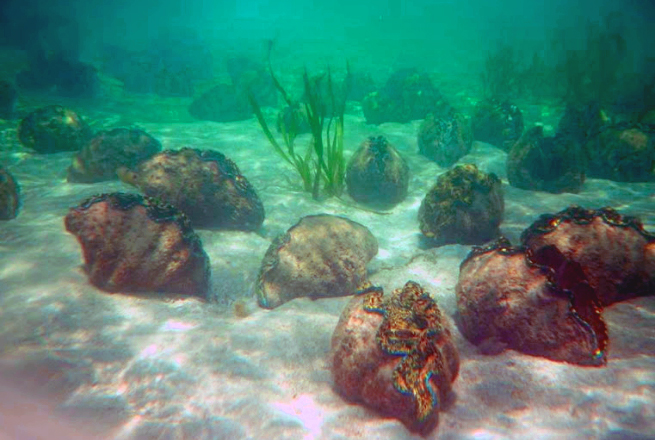
Conservation of various Tridacna clams. Samal Island. Photo: Deng Fuentes
Conservation. A large Australian government-funded project during 1985-1992 had mass-cultured Giant Clams, particularly T. gigas, at the James Cook University’s Orpheus Island Research Station, that had also supported the development of Giant Clam hatcheries in the Pacific Islands, and in the Philippines (Braley 1988). Giant Clam aquaculture farms have successfully bred various types of Giant Clams in Samal, Camiguin, and Silaqui Islands. When the larval phase ends after 15 days, and the juvenile clams nestle on the tank floor, they must be at least 4 mm in length to be transferred to a cages the ocean where they can grow faster. When they grow to about 20 cm in size, they are freed from the cages, and laid on the seabed. Some clam farms raise their animals entirely on land while others transfer their stock to the ocean at the earliest possible time. There are advantages and disadvantages to both land-based farms and ocean-based nursery farms.
The heavy investment necessary to build large nursery facilities and the 7-year growing period to bring species like T. gigas ready for meat harvesting size is not within reach of many coastal community villagers throughout the Indo-Pacific region. Instead, villagers turn their attention to the smaller species like the T. crocea, T. maxima, and T. squamosa to service the saltwater aquarium trade. It only takes 5-7 months for these species to reach a suitable size to be shipped, making them the economically feasible option (Foyle et al. 1997) compared with the T. gigas. The ability to breed tridacnids in captivity also creates opportunity to reseed depleted reefs (Beckvar 1981). In the ocean, Giant Clams can counteract excessive algal growth by filtering the algae off the water, for a healthier ocean reef ecosystem (J.Keegan 2015, Miami University). They help filter the ocean waters, recycle nutrients, and provide food and habitat for small organisms particularly in the scales of its shells, which also help form the corral reef structure.
BML Adopt-A-Clam. If you would like to help conserve our Giant Clams, please consider adopting a clam. The University of the Philippines Marine Science Institute (UPMSI) recently announced Giant Clams in the coastal town of Bolinao, Pangasinan are up for adoption. The Bolinao Marine Laboratory (BML) said:
- A baby Giant Clam will be tagged with your name, and will be placed in a special area in the ocean nursery;
- You will receive an adoption kit with a certificate; and
- BML will care of your adopted clams and regularly track their growth to adulthood.
- 3 cm-5 cm, 1-year-old clam is P200; 8 cm-12cm, 2-year-old is P300; and 15 cm-25 cm, 4-year-old is P400.
- For more information, text UP MSI at 0920-4311640 or send an e-mail to bml@msi.upd.edu.ph
Main References:
- Beckvar, N. (1981). Cultivation, Spawning, & Growth of the Giant Clams Tridacna gigas, T. derasa, & T. squamosa in Palau, Caroline Islands. Aquaculture 24: 21–30.
- Braley, R. (1988). Farming the Giant Clam. World Aquaculture. 20 (1): 7–17.
- Foyle, T.P., J.D. Bell, M. Gervis, & I. Lane (1997). Survival and growth of juvenile fluted Giant Clams, Tridacna squamosa, in large-scale grow-out trials in the Solomon Islands. Aquaculture 148: 85–104.
- Hawkins, S.J., A.J. Evans, A.C. Dale, L.B. Firth, D.J. Hughes, I.P. Smith (Eds). (2017). Oceano-graphy and Marine Biology: An Annual Review. Volume 55, CRC Press, 488 pages.
- IUCN 2017-3 Red List.
- Klumpp, D.W., B.L. Bayne, & A.J.S. Hawkins (1991). Nutrition of the Giant Clam Tridacna gigas (L.). I. Contribution of filter feeding and photosynthates to respiration and growth. Journal of Experimental Marine Biology and Ecology 155 (1): 105–122.
Knop, D. (1996). Giant Clams: a comprehensive guide to the identification and care of Tridacnid clams. Ettlingen: Dähne Verlag, ISBN 3-921684-23-4. - Kurlansky, M. (2006). The Big Oyster: History on the Half Shell. Penguin Group. p. 160. ISBN 0-345-47638-7.
- Lucas, J.S. (1994). The biology, exploitation, and mariculture of Giant Clams Tridacnidae. Rev. Fish Sci 2:181-223.
- Neo, ML. et.al. (2017). Giant Clams: A comprehensive update of species and their distribution, current threats, and conservation status. Oceanography & Marine Biology Annual Review 55: 87-388.
- Su Y., J.H. Hung, H. Kubo, and L.L. Liu. 2014. Tridacna noae (Röding, 1798) – a valid Giant Clam species separated from T. maxima (Röding, 1798) by morphological and genetic data. Raffles Bulletin of Zoology, 62:124-135.
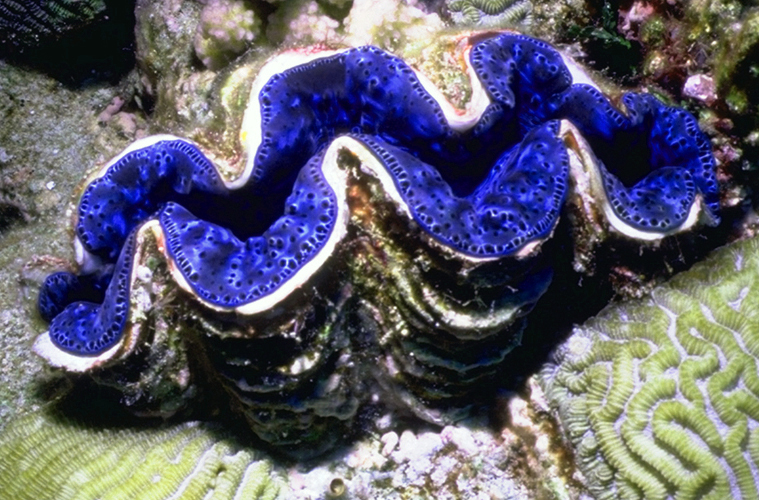
The picture shown here at the top as a T.Gigas is actually a T.Maxima, and the picture indicating a T.Maxima is a T.Derasa clam; plus the species here mentioned T.Noae and T.Ningaloo are 2 different species as different from each other as these are from T.Maxima.
I have duly cited in the photo credits the source of each picture. The species were identified by them. From my readings, even the advanced can be confused with the many similarities between the different species. I know that there are many more beautiful pictures out there, but I wanted to feature the Giant Clams living in the Philippines. Except for one, which I had to resort to selecting from Palau because the only picture I was able to source was too blurred, all the others are in the Philippines. As to the merging of T.Noae with T.Ningaloo in the article, that was based on a 2017 research publication saying that Noae and Ningaloo are one and the same, despite their little differences in looks. The paper is titled “Oceanography and Marine Biology: An Annual Review” by S.J. Hawkins, A.J. Evans, A.C. Dale, L.B. Firth, D.J. Hughes, and I.P. Smith (2017), Vol.55, Chapter 4. Specific pages are pp.4-5.
If you have pictures of Tridacnas in the Philippines, do send them to me and I would love to feature them in the online version of the article.